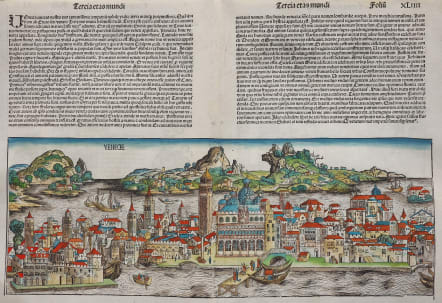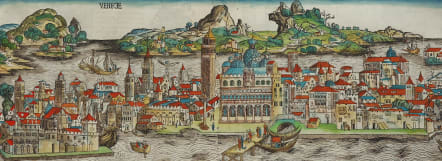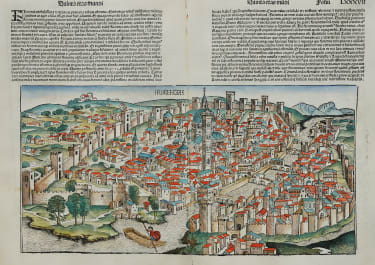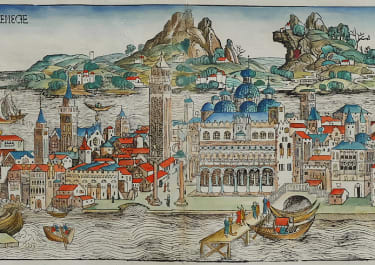VENICE VENECIE
Sold
Superb incunable double-leaf in folio showing Venice (Venezia) by Hartmann Schedel. Probably the best available example condition anywhere currently. The earliest printed folio view available.
Latin edition of the famous Liber chronicarum or Nuremberg Chronicle published in 1493, the year that Columbus returned to Europe after discovering America. Leaf number XLIIII. On verso the half-page view of Padua.
The view is based on the large woodcut plan of E. Reuwich in Peregrinatio by Bernhard von Breydenbach, Mainz 1486. This offered Schedel view is one of the oldest authentic plans of Venice and realistically the only large format 15th Century view obtainable to collectors.
The woodblock engravers Michael Wolgemut, the well-known teacher of Albrecht Dürer, and his stepson Wilhelm Pleydenwurff. Wohlgemut was Albrecht Dürer's tutor between 1486-90. Since the young Dürer was active in Wohlgemut's printer shop during the time the woodblock for the Nuremberg Chronicle have produced, he may also have collaborated, since some of the cuts bear a remarkably close resemblance to his Apocalypse illustrations.
Excellent hand colour
Very good condition
References: Moretto, #6; Fauser, #14679
code : M4927
Cartographer : Hartman SCHEDEL
Date : 1493 Nuremberg
Size : 19*53 cms Sheet 41*59.5 cms
availability : Sold
Price : Sold
Hartmann Schedel (13 February 1440 - 28 November 1514) was a German physician, humanist, historian, and one of the first cartographers to use the printing press. He was born in Nuremberg. Matheolus Perusinus served as his tutor.
Schedel is best known for his writing the text for the Nuremberg Chronicle, known as Schedelsche Weltchronik (English: Schedel's World Chronicle), published in 1493 in Nuremberg. It was probably commissioned by Anton Koberger. Maps in the Chronicle were the first ever illustrations of many cities and countries.
With the invention of the printing press by Johannes Gutenberg in 1447, it became feasible to print books and maps for a larger customer basis. Because they had to be handwritten, books were previously rare and very expensive.
Schedel was also a notable collector of books, art and old master prints. An album he had bound in 1504, which once contained five engravings by Jacopo de' Barbari, provides important evidence for dating de' Barbari's work.






